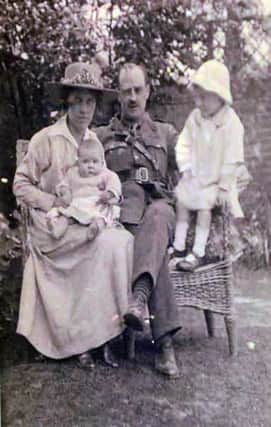Great War hero who helped stem the tide of gas attacks


YOU only have to read Wilfred Owen’s searing poem Dulce et Decorum Est to get a sense of the paralysing terror that a gas attack inflicted on troops during the First World War.
It’ is estimated that under five per cent of those who experienced a gas attack died as a result – far fewer than the number killed by artillery shells, shrapnel and machine gun fire. But if you asked most soldiers what they feared most, it was gas attacks.
Advertisement
Hide AdAdvertisement
Hide AdWhereas a bullet or a piece of shrapnel might kill you in an instant, poison gas could lead to a lingering, painful death that could take days – or sometimes even longer. Experienced soldiers in the trenches were attuned to gas attacks and quick to put on their respirators. They knew that diving into a shell hole for safety was potentially fatal as poison gas was heavier than air and would drop down into craters, with dreadful consequences for those caught unprepared.
Gas was first used by the Germans at the Second Battle of Ypres on April 22, 1915, and in doing so it introduced a terrifying new dimension to modern warfare – chemical weapons.
At the outbreak of war the British government wrote to the universities asking for chemists to help with the war effort and to devise ways of protecting people against the potentially devastating effects of poison gas. Among those who stepped forward to help was Yorkshireman Bertram Lambert, who was commissioned into the Royal Engineers as a staff captain.
Bertram is Jeanne Carr’s great-great uncle and she has been tracing his wartime story and the crucial role he played. She first heard about his involvement years ago when her grandfather, who fought in the war himself, mentioned that Bertram had invented the “box respirator” which was used to combat gas attacks. “That’s all he told me. My grandfather was in the artillery and this box respirator that my great-great uncle helped invent must have saved his life on numerous occasions,” she says.
Advertisement
Hide AdAdvertisement
Hide AdBertram was born in Settle, North Yorkshire, in 1881, the third son of the printer James Wilcock Lambert and his wife Mary. He and his four brothers – William, John, Ernest and Victor – went to what is now Settle Primary School before he won a West Riding Technical Exhibitions scholarship to Giggleswick School in 1894. “He must have been quite an exceptional pupil because from here he won another scholarship to Merton College, Oxford, where he got a First,” says Jeanne, who lives in Settle.
For some time before the war Bertram had been investigating the absorption of gases by metals. This work was to prove crucial when he and two fellow scientists looked at ways of combating gas attacks.
Exposure to gas could cause burns, temporary blindness and the lungs to dissolve. To begin with some soldiers covered their mouths with socks or rags soaked in urine to help fight against its effects. However, it quickly became evident that proper protection was needed to help prevent the harmful damage that could be caused by poison gas.
Initially protection came in the shape of the gas hood or smoke helmet; a grey flannel bag soaked with chemicals which was uncomfortable to wear. It had two eyepieces which steamed up, and a rubber mouth valve. It could only be used once so it was always necessary to carry two.
Advertisement
Hide AdAdvertisement
Hide AdThen in the autumn of 1915 Bertram and two colleagues made an important breakthrough. “He was one of three men, along with Edward Harrison and John Sadd, who worked on the box respirator,” says Jeanne. It consisted of a tin cylinder filled with chemicals that had an air inlet valve at the bottom. The cylinder was connected to a face mask by a rubber tube that contained a valve.
“The face mask had two elastic bands attached which slipped over the head and held the mask in position. The whole thing was issued in a waterproof satchel.” Fresh air was drawn in through the cylinder and the mixture of charcoal, permanganate and soda lime, in layers separated by gauze, was designed to filter gas from the air to make it breathable.
Within a couple of months of the first gas attack they had produced this new respirator and it was issued to soldiers early the following year. It continued to be used by all the allies apart from the French right up until the Armistice.
This crucial invention saved countless lives and meant that poison gas became a much less potent weapon in the latter part of the war.
Advertisement
Hide AdAdvertisement
Hide AdBertram was promoted to the rank of major in 1916 and became a chemical advisor to the military top brass in France. He was twice mentioned in dispatches and awarded an OBE for his work. After the war ended he was awarded £12,500 (roughly £560,000 in today’s money) by the Royal Commission on Awards and Inventions, one of only a handful of chemists to be rewarded for their war work.
“It seems like he was quite reluctant to accept the award, but Edward Harrison had died by that time so perhaps he felt he should accept it in recognition of what the three of them had done together.”
For Jeanne, researching his wartime contribution has been a deeply rewarding experience. “There was a real fear of gas attacks among soldiers in the First World War and that’s why I feel Bert should have more recognition for his work because it made such a big difference,” she says.
Bertram and his fellow scientists don’t have a statue in their honour but their tireless work to help save lives, rather than end them, should never be forgotten.